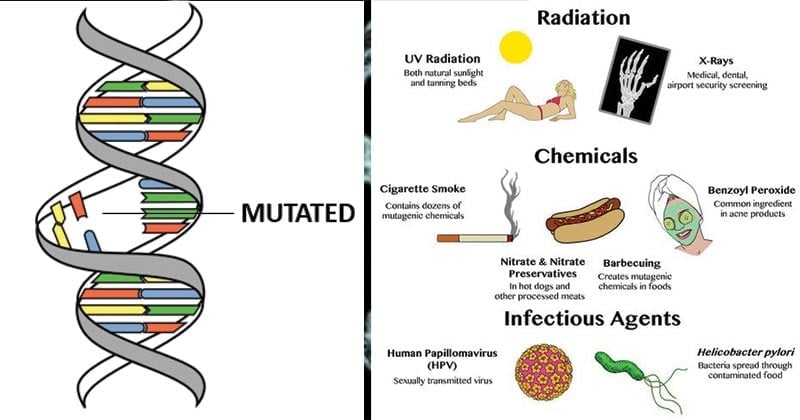- Mutation is a process that produces a gene or chromosome that differs from the wild type (arbitrary standard for what “normal” is for an organism).
- It is most commonly defined as a spontaneous permanent change in a gene or chromosome which usually produces a detectable effect in the organism concerned and is transmitted to the offsprings.
- Mutated gene or chromosome results from a mutational process while the organism or cell whose changed phenotype is attributed to a mutation is said to be a mutant.
- The mutation may result due to changes either on the gene or the chromosome itself. Thus, broadly mutation maybe:
- Gene mutation where the allele of a gene changes.
- Chromosome mutation where segments of chromosomes, whole chromosomes, or entire sets of chromosomes change.

Interesting Science Videos
Causes and Mechanisms of Mutation
- Errors in DNA replication.
- Errors in DNA repair.
- Environmental mutagen causes DNA damage that is not repaired correctly.
- Transposons and insertion sequences (a mobile DNA elements that can move from one location in the chromosome to another; the element may “jump” into a gene thereby mutating it).
- External Causes: Mutagenic agents that damage DNA such as chemical mutagens, physical mutagens or biological mutagens.
Agents of Mutations
- The substances or agents which induce artificial mutations are called mutagenes or mutagenic agents.
- Mutagens may be of physical, chemical or biological origin.
- They may act directly on the DNA, causing direct damage to the DNA, and most often result in replication error.
- Some however may act on the replication mechanism and chromosomal partition.
- Many mutagens are not mutagenic by themselves, but can form mutagenic metabolites through cellular processes, for example through the activity of the cytochrome P450 system and other oxygenases such as cyclooxygenase.
- The mutagenic agents are of the following kinds:
Radiation and Radioactive Decays
- Ionizing radiations such as X-rays, gamma rays and alpha particles cause DNA breakage and other damages. The most common lab sources include cobalt-60 and cesium-137.
Ionizing radiations cause breaks in polysugar phosphate backbone of DNA and, thus, causing chromosomal mutations such as break, deletion, addition, inversion and translocation. - Ultraviolet radiations with wavelength above 260 nm are absorbed strongly by bases, producing pyrimidine dimers, which can cause error in replication if left uncorrected.
- Radioactive decay, such as 14C in DNA which decays into nitrogen.
Temperature
- The rate of all chemical reactions are influenced by temperature. It is reported that the rate of mutation is increased due to increase in temperature.
- For example, an increase of 10°C temperature increases the mutation rate two or three fold.
- Temperature probably affects both thermal stability of DNA and the rate of reaction of other substances with DNA.
Chemical Agents
- Many chemical substances have been responsible to increase the mutability of genes.
- Any chemical substance that affects the chemical environment of chromosomes is likely to influence, at least indirectly, the stability of DNA and its ability to replicate without error.
- Some of the known chemical mutagens include:
- Reactive oxygen species (ROS) These may be superoxide, hydroxyl radicals and hydrogen peroxide, and large number of these highly reactive species which are generated by normal cellular processes.
- Deaminating agents, such as nitrous acid which can cause transition mutations by converting cytosine to uracil.
- Polycyclic aromatic hydrocarbon (PAH), when activated to diol-epoxides can bind to DNA and form adducts.
- Nitrosaminesare an important group of mutagens found in tobacco, and may also be formed in smoked meats and fish via the interaction of amines in food with nitrites added as preservatives. Other alkylating agents include mustard gas and vinyl chloride.
- Alkaloidfrom plants, such as those from Vinca species, may be converted by metabolic processes into the active mutagen or carcinogen.
- Benzene, an industrial solvent and precursor in the production of drugs, plastics, synthetic rubber and dyes.
Biological agents
- Transposon is a section of DNA that undergoes autonomous fragment relocation/multiplication. Its insertion into chromosomal DNA disrupts functional elements of the genes.
- Virus– Virus DNA may be inserted into the genome which disrupts genetic function. Infectious agents have been suggested to cause cancer as early as 1908 by Vilhelm Ellermann and Oluf Bang, and 1911 by Peyton Rous who discovered the Rous sarcoma virus.
- Bacteria– some bacteria such as Helicobacter pylori cause inflammation during which oxidative species are produced, causing DNA damage and reducing efficiency of DNA repair systems, thereby increasing mutation.
Significance of Mutations
- Variants in genes (which are caused by mutations) are needed to study the transmission of traits.
- Mutations can tell the researcher about the function of a gene product in a biological system.
- Mutations are the basis for cancer and other genetic diseases.
- Gene mutations serve as the source for most alleles in a population and is therefore the origin of genetic variation within a population.
- Mutations drive evolution: mutations are the raw material upon which natural selection acts.
References
- Verma, P. S., & Agrawal, V. K. (2006). Cell Biology, Genetics, Molecular Biology, Evolution & Ecology (1 ed.). S .Chand and company Ltd.
- https://facultystaff.richmond.edu/~lrunyenj/bio554/lectnotes/CHAPTER7.PDF
- https://www.golifescience.com/mutations-and-its-types/
- https://en.wikipedia.org/wiki/Mutagen
- https://biologydictionary.net/mutation/
- http://kmbiology.weebly.com/mutations—notes.html
- https://www.tcd.ie/Biology_Teaching_Centre/assets/pdf/by1101/jfby1101/jfby1101-lecture7-2013-bw.pdf
